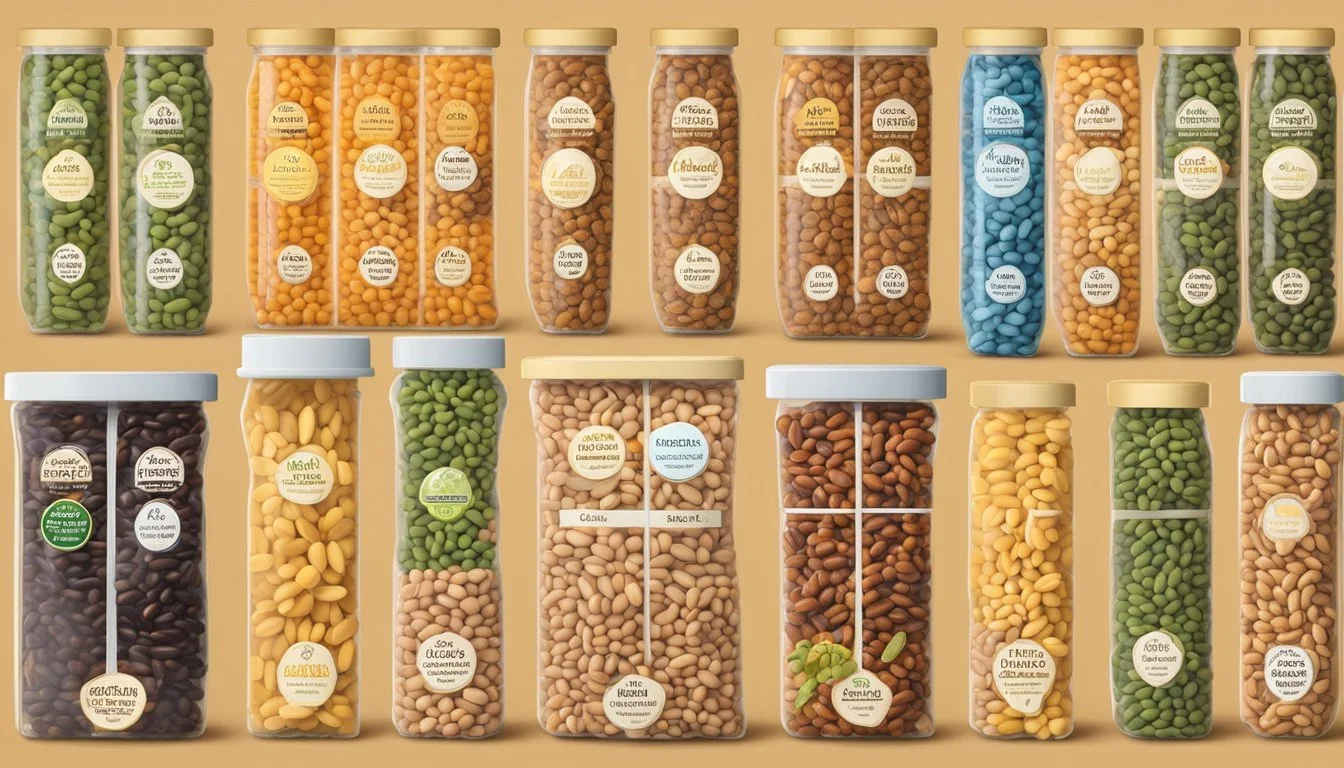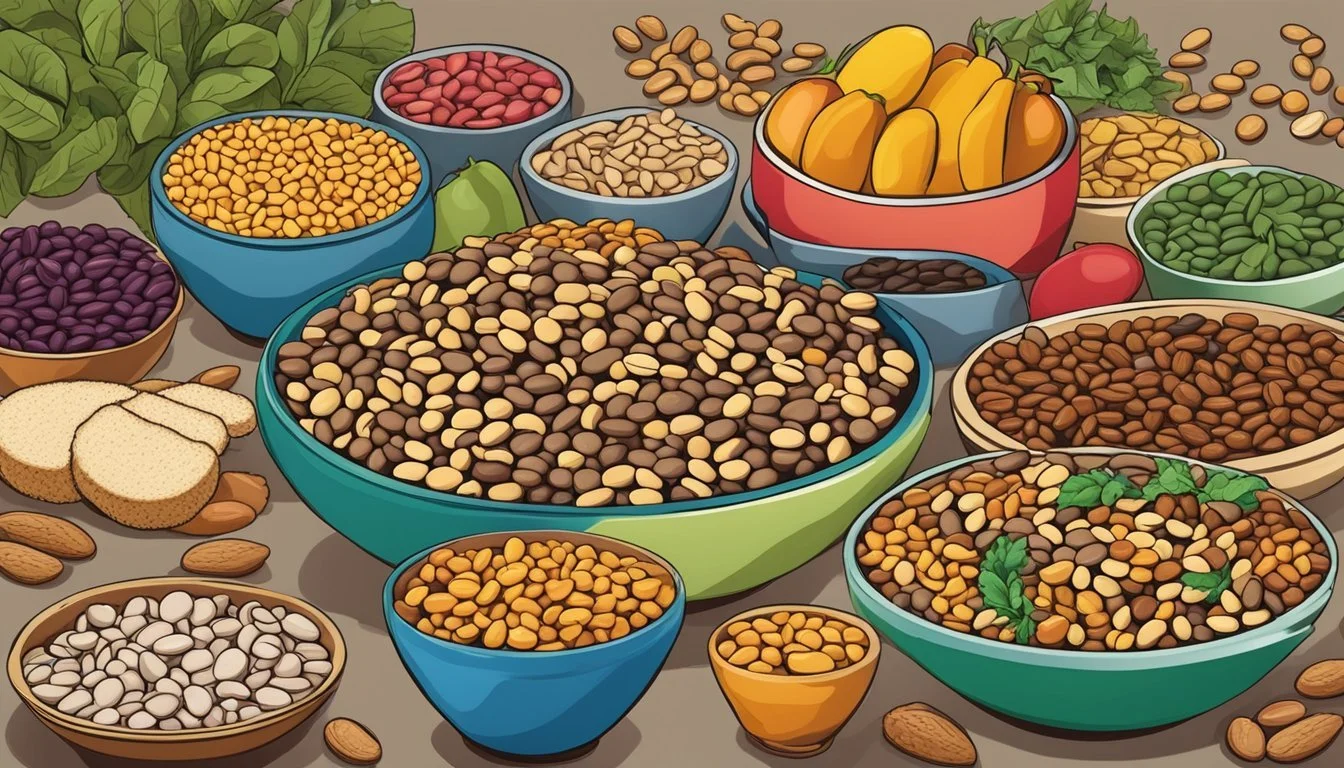Lablab Beans Substitutes
Top Alternatives for Cooking and Nutrition
Finding the right substitute for lablab beans can elevate your dishes if they're unavailable. Lablab beans are known for their nutty flavor and rich nutritional profile, but several alternatives can provide similar taste and nutrition. When seeking a readily available and versatile option, consider using chickpeas or black-eyed peas, both of which can mimic the texture and nutritional benefits of lablab beans.
For those looking to maintain the distinct beany flavor in their recipes, pigeon peas or fava beans are excellent choices. These alternatives require similar preparation methods, such as soaking and boiling, making them convenient options in various dishes. By exploring these substitutes, you can ensure your meals remain flavorful and nutritious without the specific ingredient.
Understanding Lablab Beans
Lablab beans, also known as Lablab purpureus, belong to the Fabaceae family. They are a versatile legume cultivated primarily in Africa and Asia.
Lablab beans are remarkable for their high protein content, making them a valuable source of nutrients. These beans are known for their significant levels of fiber.
In addition to protein and fiber, lablab beans are rich in vitamins and minerals. They contain notable amounts of iron, calcium, potassium, and magnesium.
Nutrient Comparison
Nutrient Lablab Beans Protein High Fiber High Iron Present Calcium Present Potassium Present Magnesium Present
The leaves, roots, flowers, pods, and beans of lablab beans are all edible. However, the raw beans contain toxins and must be boiled to be safe for consumption.
In cooking, lablab beans can be used similarly to other legumes, adding nutritional value to soups, stews, and salads. Their versatility extends to both human diets and as fodder for animals.
They also serve as a fantastic substitute for spinach due to their nutritional profile. The high iron and protein content in the leaves contribute significantly to their dietary value.
Culinary Uses of Lablab Beans
Lablab beans, known for their versatility, are used in various culinary applications such as traditional dishes, innovative cooking techniques, and refreshing salads. These beans are prized for their high protein and nutrient content, making them a nutritious choice for many recipes.
Traditional Dishes
In many cultures, lablab beans are central to traditional curries and stews. In Indian cuisine, they feature prominently in dishes like Hyacinth Bean Curry, often cooked with spices like cumin, coriander, and turmeric to enhance their flavor.
In African cuisine, these beans are boiled and incorporated into rich, hearty soups and stews. Filipino cuisine refers to them as "bataw," using them in meat-based dishes to add texture and nutrition. Their rich heritage in global cuisines highlights their adaptability to various flavor profiles and cooking methods.
Cooking Techniques
Proper preparation is essential, as raw lablab beans contain toxins that must be neutralized by boiling. First, the beans should be soaked overnight to soften them. They are then boiled until tender, usually for about 20-30 minutes, depending on the size and age of the beans.
These cooked beans can be seasoned with salt, pepper, and herbs to create a delicious side dish. They are also ideal for adding to soups, stews, and even meat-based dishes. Lablab beans can be mashed and mixed with spices to create tasty bean patties or fritters.
Lablab Beans in Salads
Lablab beans add both texture and nutritional value to salads. Once boiled and cooled, they can be tossed into various salad recipes alongside fresh vegetables, herbs, and a light vinaigrette. Their firm texture makes them an excellent addition to grain salads, such as quinoa or bulgur, enhancing the dish's overall protein content.
For a simple yet nutritious salad, mix lablab beans with cherry tomatoes, cucumber, red onion, and a squeeze of lemon juice. Adding ingredients like feta cheese or olives can also complement their delicate flavor, making for a refreshing and wholesome meal option.
Nutritional Profile of Lablab Beans
Lablab beans, also known as Hyacinth beans, are a nutrient-rich legume. They provide an excellent source of protein, making them a valuable addition to vegetarian and vegan diets. Each serving offers essential amino acids which are necessary for muscle repair and growth.
These beans are also high in fiber, aiding in digestion and promoting gut health. Rich in iron, lablab beans help in maintaining healthy blood levels and preventing anemia. Each serving delivers approximately 39% more iron compared to fava beans.
Among the minerals, lablab beans contain notable amounts of calcium and phosphorus, which are crucial for bone health. They are also a good source of magnesium, with 82mg per serving, which supports muscle function and energy production.
Furthermore, lablab beans are packed with essential vitamins including folate—an important nutrient for cell division and DNA synthesis. Even though their folate content is lower than that of lima beans, it still contributes to overall health.
For those monitoring their cholesterol intake, lablab beans are a healthy choice as they contain no cholesterol. The potassium in these beans helps regulate blood pressure, while zinc supports immune function and wound healing.
The nutritional profile of lablab beans makes them a versatile and beneficial food choice, fit for inclusion in various dietary plans. Here's a quick summary in table form:
Nutrient Amount (per serving) Protein High Fiber High Iron High Calcium Moderate Potassium Moderate Magnesium 82mg Vitamins Includes Folate Zinc 2.85mg Cholesterol None
Lablab beans stand out as a nutritious food that supports various aspects of health due to their rich content of proteins, fibers, minerals, and vitamins.
Benefits of Including Lablab Beans in Your Diet
Lablab beans are rich in various nutrients such as protein, iron, and fiber. They offer significant health benefits related to cardiovascular health, digestive well-being, and weight management.
Cardiovascular Health
Lablab beans are an excellent source of plant-based protein and essential minerals like iron and magnesium. These nutrients help maintain healthy heart function by supporting the production of red blood cells and reducing the risk of anemia. They are also low in fat and cholesterol, making them heart-friendly.
Dietary fiber in lablab beans helps lower blood cholesterol levels, reducing the risk of heart disease. Regular consumption can promote better blood circulation and reduce hypertension. Including these beans in a balanced diet supports overall cardiovascular health.
Digestive Well-being
Loaded with dietary fiber, lablab beans aid in maintaining a healthy digestive system. Fiber promotes regular bowel movements and prevents constipation. It acts as a natural cleanser, helping to remove waste and toxins from the body effectively.
Lablab beans also contain essential nutrients like zinc and vitamin B1, which support gut health and improve digestive enzyme function. These beans can alleviate symptoms of digestive disorders and maintain a balanced gut microbiome, offering a natural way to enhance digestive well-being.
Weight Management
The high-protein and high-fiber content of lablab beans make them an ideal food for weight management. Protein helps build and repair tissues while keeping you full for longer periods, reducing overall calorie intake. Fiber adds bulk to the diet, promoting a feeling of fullness and preventing overeating.
Additionally, lablab beans are low in fat and calories, making them a nutritious option for those looking to maintain or lose weight. Including them in meals can help manage weight effectively without compromising on essential nutrients.
Substitute Options for Lablab Beans
When replacing lablab beans in recipes, several viable alternatives are available. These can be broadly categorized into legume substitutes, optimal substitutes for specific dishes, and non-legume options for those with dietary restrictions.
Similar Legume Substitutes
Pinto Beans: These beans provide a rich, nutty flavor similar to lablab beans. They're excellent in soups and stews.
Navy Beans: Known also as Boston beans, navy beans can replace lablab beans in baked dishes. They absorb flavors well and have a creamy texture.
Kidney Beans: Kidney beans offer a comparable texture and are ideal for chili and hearty stews. Their robust flavor pairs well with strong spices.
Black Beans: Black beans have a slightly sweeter taste and are great for Latin American dishes, like burritos and enchiladas.
Substitutes for Specific Dishes
Stews and Soups: Pinto beans and kidney beans work particularly well due to their ability to absorb flavors and maintain texture during long cooking times.
Salads and Cold Dishes: Cannellini beans and chickpeas (garbanzo beans) are preferable. Both have a firm texture and mild flavor, making them perfect for cold dishes.
Curries and Spicy Dishes: Black beans and fava beans hold their shape and can stand up to heavy spices, providing both texture and flavor depth.
Baked Dishes: Navy beans and white kidney beans can be used in casseroles and baked beans recipes. Their ability to blend well with other ingredients makes them ideal for these dishes.
Non-Legume Alternatives
Quinoa: Quinoa is a protein-rich grain that can substitute lablab beans in salads and side dishes. Its nutty flavor and fluffy texture make it versatile.
Edamame and Soybeans: These can be used in stir-fries and salads. Both are high in protein and offer a firm, crunchy texture.
Tofu and Tempeh: For vegetarian or vegan options, tofu and tempeh provide a nutritious alternative. They're suitable for stir-fries, curries, and salads.
Green Peas: Ideal for lighter dishes such as salads and soups, green peas add a sweet flavor and bright color.
Nuts (e.g., Almonds): Almonds can be chopped and added to salads for a crunchy, protein-packed substitute. They're best used for cold or lightly cooked dishes.
Preparing Lablab Beans for Cooking
Lablab beans require specific preparation techniques to ensure they are safe and delicious for consumption. Proper soaking and boiling can eliminate toxins and enhance their texture and flavor.
Soaking Methods
Soaking lablab beans is essential to reduce cooking time and improve digestibility. For best results, dry beans should be soaked overnight in cold water.
Alternatively, a quicker method involves soaking the beans in hot water for 2-3 hours. In either case, the beans should be fully submerged, with water levels well above the beans to account for expansion. Adding ½ teaspoon of baking soda can further soften the beans and reduce gas-producing compounds.
Method Water Type Time Required Overnight Soak Cold 8-12 hours Quick Soak Hot 2-3 hours
Boiling and Simmering
Once soaked, draining and rinsing the beans is crucial before boiling. Place the beans in a large pot with fresh water; the water level should be at least two inches above the beans.
Bring the water to a vigorous boil, then reduce the heat to a simmer. Boil the beans for one hour, ensuring they are tender and safe to eat. For additional flavor, add seasonings such as salt, pepper, or herbs during the last 10 minutes of cooking. If using in stews, soups, or other dishes, adjust the simmering time accordingly to blend flavors fully.
Properly boiled lablab beans make a versatile ingredient, perfect for various recipes while ensuring they are toxin-free and palatable.
Allergy and Dietary Considerations
When considering substitutes for lablab beans, it's essential to address common food allergies and dietary preferences. Lablab beans, like many legumes, can cause reactions, particularly in those with existing legume allergies.
People with peanut or soy allergies—both of which are legumes—may also react to lablab beans. It is crucial to read labels and consult with healthcare providers if unsure.
For vegans and those with dietary restrictions, several alternatives can be considered. Lentils, chickpeas, and black beans are great substitutes. These options are also high in protein and iron, fitting well within a plant-based diet.
For those who require a gluten-free option, substitutes like lentils, chickpeas, and black beans also serve well. These legumes are naturally free from gluten and can be used in a variety of dishes.
Here is a simple table to illustrate some potential substitutes:
Substitute Allergen-Free Vegan Gluten-Free Lentils Yes Yes Yes Chickpeas Yes Yes Yes Black Beans Yes Yes Yes
Note: Always ensure to double-check product labels and ingredients, as cross-contamination can occur during processing.
For those who need to avoid both tree nuts and peanuts, sunflower seeds, sesame seeds, or pepitas can be used as additional alternatives in recipes. Additionally, roasted soybeans, chickpeas, and peas provide a crunchy texture similar to lablab beans.
Common Varieties of Lablab Beans
Lablab beans, often referred to as hyacinth beans, come in a few noteworthy varieties. These beans are versatile and grown in different regions, especially in India where they are quite popular.
Varieties
Val Beans (Indian Broad Beans): Found primarily in India, Val beans are known for their edible pods. They are cultivated for their tender pods, seeds, and even leaves.
Purple Hyacinth Bean: Recognizable by their striking purple flowers and pods. This variety is often grown for ornamental purposes as well as for consumption.
Features
Pods: Both the val and purple hyacinth varieties have edible pods that must be cooked due to naturally occurring toxins.
Flowers: The flowers of the purple hyacinth bean are vibrant and sometimes used in salads.
Nutrient Profile
Lablab beans are rich in:
Iron: High levels, particularly in Val varieties.
Zinc: Higher in comparison to many other legumes.
Vitamin B1: Present to support energy metabolism.
Magnesium: Important for bone health and enzymatic functions.
This diverse range of varieties and nutrient-rich profile makes lablab beans a valuable addition to diets in various cuisines.
Enhancing Flavors and Textures
Enhancing the flavors and textures of Lablab beans involves selecting complementary ingredients and adding specific herbs and spices to elevate your dish. These additions help bring out the beans' nutty flavor and creamy texture while adapting to various cuisines.
Complementary Ingredients
Incorporating ingredients like tomatoes, onions, and garlic enhances the taste of Lablab beans. Tomatoes add acidity and brightness, while onions and garlic provide depth and complexity.
Fat sources such as olive oil or ghee can improve the mouthfeel, making the beans richer. Additionally, combining Lablab beans with other beans such as black beans or butter beans can offer textural variety.
Blending in cooked vegetables like bell peppers or carrots complements the beans' neutral taste, making the dish more flavorful.
Herbs and Spices for Lablab Beans
Cumin is a go-to spice for Lablab beans, providing a warm, earthy flavor that complements their creamy texture.
Other beneficial spices include turmeric for color and coriander for a citrusy touch. Fresh herbs like cilantro or parsley can add freshness to the dish, while dried herbs like thyme or oregano offer depth.
For a spicy kick, adding chili powder or red pepper flakes can enhance the nutty flavor of the beans. These components work well in various cuisines, from Indian curries to Mediterranean stews.









